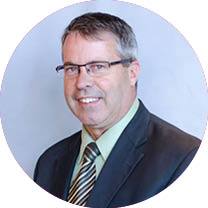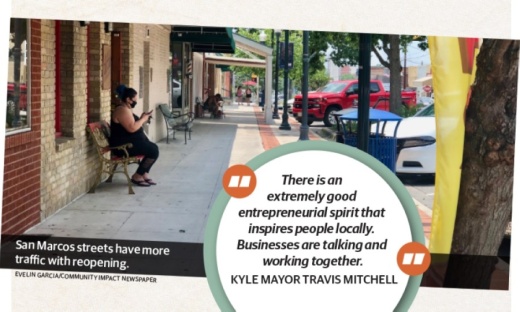Leaders in Hays County were charged with protecting their residents, co-workers, businesses, teachers and students as the unknown threats of the coronavirus gripped the area.
Several said it was the most challenging time in their career. Others relied on military experience to help guide them, and others said they were initially scared but jumped into action.
“This was a little bit different than anything I’ve been through,” said Buda City Manager Kenneth Williams, who has experience as an emergency management coordinator and led responses to the Space Shuttle Columbia tragedy, Hurricane Katrina and Hurricane Rita during his career. “None of it compares to COVID-19.”
Williams credits his team of city officials for quick response and for being prepared. Helpful, he said, was the military background of Mayor George Haehn as they stepped into action.
“We were well-prepared,” Williams said. “We have a fantastic team. Everybody, our police force, essential employees and the residents of Buda did a good job here. We are responding to a major catastrophe.”
While no one who took a job as city manager, superintendent or police chief to handle what they have faced since March, they stepped up with one goal—to protect the residents of their cities, schools and Hays County.
Taking charge in the beginning
In the early days of coronavirus in March, Kyle Mayor Travis Mitchell said he was told 1,000 of his 48,393 residents could die. He said he jumped into action immediately.
“In the very beginning, we had to institute policies we never considered in our lives,” Mitchell said. “Before restrictions were issued, we had scary and hard conversations. We wanted to make sure we were making the right decisions.”
Those decisions included stricter mandates on day cares, gas stations and other businesses. While many parks in Hays County closed, the city of Kyle followed suit, but new trails were opened in April to help residents have the opportunity to exercise while adhering to the guidelines of social distancing.
“Our residents and business community have been fantastic in the city of Kyle,” Mitchell said. “We have extraordinary leaders here. Not every [business] is being affected the same way.”
Mitchell said many residents commute for their jobs, so the daytime population that has stayed home and worked from home has fed the local economy in a different and positive way.
Hays CISD has more than 21,000 students and serves the I-35 corridor from San Marcos CISD north. As the coronavirus became an issue, spring break was extended a week. The district then set goals for opening that were extended through a declaration by Gov. Greg Abbott that all schools close for the remainder of the year beginning May 1.
San Marcos CISD and Hays CISD immediately put into action online and packet learning for students while maintaining meal programs for students.
HCISD Superintendent Eric Wright said he was proud how staff, teachers, students and parents all came together.
“I will forever be grateful for everybody in this,” Wright said. “We’ve been blessed to see so many people step up. We preached kindness, flexibility and grace. I think we accomplished that.”
Wright said at first education took a back seat to the safety of the community. Tracking students showed the need for updated contact information, but at the end of the year, all except 52 students had been contacted and had the option of learning with homework packets or virtually if they had access to internet and a device. The district provided hotspots for internet access to as many students who needed it.
“Overall, I felt like we had remarkable speed as we ramped up to virtual teaching,” Wright said. “We had better communication and collaboration in many areas.”
Wright said the virtual learning is not as valuable as in-person teaching, and he hopes starting the 2020-21 school year will include a version of that.
“Unless [coronavirus] isn’t a threat anymore, education will have to change,” Wright said. “All the content skills are important, but social, emotional and teaching help also comes by visiting from peers. Students learn as much from each other as they do from us.”
A challenge for law enforcement
In San Marcos, Director of Public Safety Chase Stapp said his city changed overnight as coronavirus closed businesses and parks. Calls for law enforcement help “didn’t go down as much as you would think,” Stapp said. He said he led his city of 64,776 with a “servant’s heart” as the San Marcos Police Department was struck by tragedy in April.
“In the first couple weeks, it was really a blur,” Stapp said. “We were dealing with things we have never dealt with before and we leveraged our partnerships with our regional partners. We initially saw a downward trend in police calls for service. Then we were dealing with more mental health calls and domestic violence calls.”
On April 18, while responding to a domestic violence call at Twin Lake Villas Apartments, three officers were, according to the city, ambushed by a gunman as the officers entered the apartment. Officer Justin Putnam was killed. The other two suffered critical injuries. For a department that has had several tragic events over the years, including another officer hit by a motor vehicle along I-35 in March, Stapp said community support has been good for his department.
“We can’t get through this alone,” Stapp said of the support. “It has brought us together, and we are getting through it. But you never get through it. The support has been pretty overwhelming.”
Police work during the coronavirus pandemic, especially in a city that has a river running through the parks, has been a challenge.
“We were very busy [the weekends of May 15 and May 22],” Stapp said. “Our police officers and park rangers aren’t public health and safety police. We try to understand what the real wishes are for the community.”
In the beginning of reopening, Stapp said many residents sent police photos and complaints of perceived violations. That has since calmed down, he said.
Sharing information with the community
The public has sought more information than ever during the coronavirus pandemic, according to Buda Communications Director David Marino.
“In this situation, they really were looking to us for direction and also to let them know everything was going to be OK,” Marino said. “We wanted to be really transparent, and we had a lot of people reaching out.”
The chambers of commerce were quick to act providing support to businesses. In Buda, the Still Budaful and Still Budaful 2.0 grants and loans programs will provide nearly $500,000 for Buda businesses.
“We were one of the leaders in the state [getting money to local businesses],” Williams said.
Buda, as with San Marcos and Kyle, also helped residents with utility payments, hotels with low occupancy numbers and businesses get through being closed. More than 70 businesses received funding in Buda’s program.
“We’re still getting through it,” Williams said. “It’s not over.”
As local officials worked with one another, including Hays County and the Hays County Local Health Department with the cities, Mitchell said there is frustration dealing with a health pandemic when it comes to HIPAA laws, which protects personal information of patients.
“Our numbers, we jumped right out in first place and expanded our lead,” said Mitchell, whose city has right around 50% of the county’s positive cases as of May 28. “Under HIPAA, they are not allowed to give some information. There is some merit to that. But we were a hotbed for transmission. That’s why we took extra steps with day cares and other businesses. It’s frustrating that we can’t have facts and data before making decisions.
“I felt we did well,” Mitchell said. “It was comforting to see we weren’t going to have that many deaths.”
What comes next with the pandemic?
The next challenge for leaders in the community is to continue keeping the spread of the coronavirus low with social distancing guidelines while allowing activities to pick up.
On top of that, SMCISD and HCISD will start new budget years July 1 with some uncertainty of what the school year will look like and the financial toll down the road.
Wright said Hays CISD will not add positions this school year and right now, “there are more questions than answers for us.
“It’s hard for our demographer to ascertain how many students will be back, and we don’t know what that looks like at this point,” Wright said.
Wright said his career in leadership had him guiding through two hurricanes, swine flu and bird flu.
“This doesn’t seem to have an end point yet,” Wright said. “This is at the top of challenges. But I’m hopeful.”
Mitchell said he is encouraged by his city’s drive to be responsible in reopening.
“There is an extremely good entrepreneurial spirit that inspires people locally,” Mitchell said. “Businesses are talking and working together.”
Williams said the April sales tax allocation from the state will help show the city where it is financially due to economic hit of the coronavirus.
“We are in good condition financially,” Williams said. “Our plan for next year is to hold the line. We are in wait-and-see mode.”





